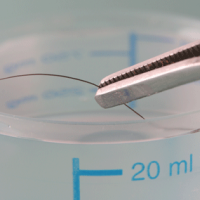Is this the Worst of the FBI Fake Hair Analysis Injustice Cases?

George Perrot has spent nearly three decades in prison because a single hair found at a crime scene led to his conviction. Perrot’s case is just one of hundreds and perhaps more that were impacted by at least two decades of flawed hair-analysis testimony provided by the Federal Bureau of Investigation’s (FBI) forensic unit.
Perrot was convicted of breaking into a 78-year-old woman’s Springfield, Massachusetts, home and raping her in 1985. No physical evidence tying him to the crime scene was found by police. No semen. No blood. The victim even told the court that Perrot didn’t look anything like her attacker.
But a single strand of hair was found on the woman’s bed. During Perrot’s trial, an FBI agent named Wayne Oakes—who described himself as a hair and textile fiber expert— testified before the jury that he could tell that strand of hair belonged to Perrot.
It didn’t matter that the rape hadn’t occurred on the victim’s bed, nor that the serial rapes of elderly women, presumed perpetrated by a single man, continued after Perrot’s arrest.
That one piece of testimony about a hair by FBI agent Oakes ruined Perrot’s life.
But now, after Perrot spent nearly 30 years in prison, it turns out that Oakes testified wrongly about that hair analysis, as did many other experts at the FBI in hundreds of other cases. Since 2012, an ongoing review by the FBI of its forensics operation has concluded that flawed testimony by FBI examiners was given in 95% of cases involving hair analysis over the course of more than 20 years.
The investigation continues and the final numbers aren’t in, but the FBI’s flawed hair-analysis testimony may have impacted tens of thousands of criminal cases, according to the man who is representing Perrot in his plight, the Innocence Project’s Chris Fabricant.
“Over the past few years, advanced understanding in the science of hair types has left hair analysis, as a forensic tool, in tatters,” Ed Pilkington wrote at The Guardian. “Today’s consensus by real experts is more straightforward than ever: there is nothing that can credibly be said, by FBI-approved analysts or anyone else, about the frequency with which particular characteristics of hair are distributed in the human population.”
“In other words, microscopic analysis of hair – the very analysis that put George Perrot and so many people behind bars – is virtually worthless as a method of identifying someone,” Pilkington added.
In spite of the FBI’s admission of its own culpability, Perrot remains behind bars for a crime he most certainly didn’t commit. A hearing on the matter is scheduled for this summer, but the state of Massachusetts has already made its position clear: It is firmly opposed to a retrial of George Perrot.
-Noel Brinkerhoff, Danny Biederman
To Learn More:
Thirty Years in Jail for a Single Hair: The FBI's 'Mass Disaster' of False Conviction (by Ed Pilkington, The Guardian)
Are The FBI’s Flawed Hair Matches Wrong Only When DNA Proves It? (by Martin Yant, Wrongful Convictions Blog)
FBI Admits Elite Forensic Unit Gave “Flawed” Testimony in almost every Hair Analysis Case (by Danny Biederman and Noel Brinkerhoff, AllGov)
FBI Ordered to Resume Review of Cases that May be Tainted by Two Decades of Flawed Forensics (by Noel Brinkerhoff, AllGov)
Federal Review Challenges Legitimacy of 27 Death Penalty Convictions based on Hair Analysis (by Noel Brinkerhoff, AllGov)
- Top Stories
- Unusual News
- Where is the Money Going?
- Controversies
- U.S. and the World
- Appointments and Resignations
- Latest News
- Trump to Stop Deportations If…
- Trump Denounces World Series
- What If China Invaded the United States?
- Donald Trump Has a Mental Health Problem and It Has a Name
- Trump Goes on Renaming Frenzy






Comments